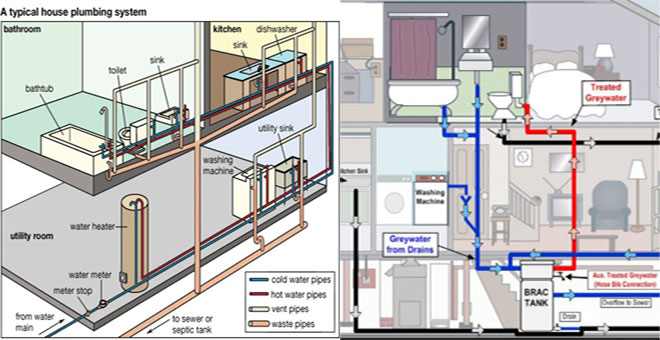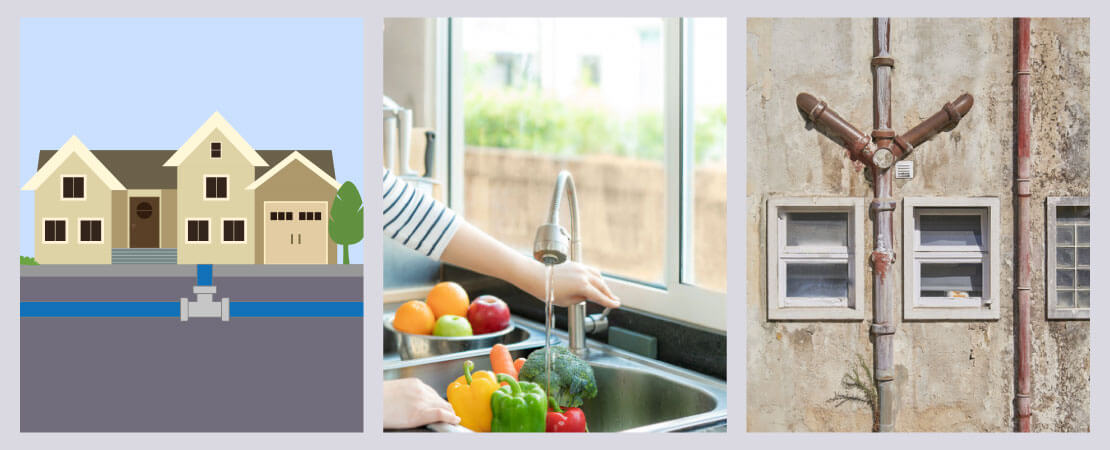The Basics of Your House's Plumbing System Anatomy
The Basics of Your House's Plumbing System Anatomy
Blog Article
This great article down below in relation to Understanding Your Home's Plumbing Anatomy is incredibly fascinating. You should keep reading.

Recognizing how your home's pipes system functions is essential for every property owner. From providing tidy water for drinking, food preparation, and showering to safely eliminating wastewater, a properly maintained pipes system is crucial for your family's wellness and comfort. In this extensive guide, we'll check out the detailed network that makes up your home's plumbing and deal pointers on maintenance, upgrades, and dealing with typical concerns.
Introduction
Your home's plumbing system is more than simply a network of pipelines; it's an intricate system that ensures you have access to tidy water and reliable wastewater elimination. Knowing its components and how they interact can help you prevent expensive repair services and make sure every little thing runs efficiently.
Basic Components of a Plumbing System
Pipes and Tubing
At the heart of your plumbing system are the pipelines and tubes that lug water throughout your home. These can be made from numerous products such as copper, PVC, or PEX, each with its advantages in terms of toughness and cost-effectiveness.
Fixtures: Sinks, Toilets, Showers, etc.
Fixtures like sinks, bathrooms, showers, and tubs are where water is utilized in your house. Comprehending exactly how these components link to the plumbing system helps in detecting problems and planning upgrades.
Shutoffs and Shut-off Points
Shutoffs regulate the flow of water in your plumbing system. Shut-off valves are critical throughout emergencies or when you require to make repair services, enabling you to isolate parts of the system without interfering with water flow to the entire house.
Water System System
Key Water Line
The primary water line attaches your home to the local supply of water or a personal well. It's where water enters your home and is distributed to various components.
Water Meter and Stress Regulatory Authority
The water meter procedures your water use, while a pressure regulatory authority makes certain that water moves at a risk-free pressure throughout your home's pipes system, stopping damage to pipelines and fixtures.
Cold Water vs. Hot Water Lines
Recognizing the difference between cold water lines, which supply water straight from the primary, and hot water lines, which carry warmed water from the hot water heater, assists in troubleshooting and preparing for upgrades.
Drain System
Drain Water Lines and Traps
Drain pipes carry wastewater away from sinks, showers, and toilets to the sewage system or septic system. Traps prevent sewage system gases from entering your home and likewise trap particles that might cause obstructions.
Air flow Pipes
Air flow pipelines permit air right into the drain system, avoiding suction that can slow down drain and trigger traps to vacant. Appropriate ventilation is necessary for preserving the integrity of your pipes system.
Importance of Correct Drain
Ensuring appropriate drainage stops backups and water damages. Frequently cleaning drains pipes and maintaining catches can prevent pricey repairs and expand the life of your plumbing system.
Water Heating Unit
Kinds Of Water Heaters
Hot water heater can be tankless or traditional tank-style. Tankless heating systems warm water as needed, while storage tanks save heated water for prompt use.
Updating Your Pipes System
Reasons for Updating
Upgrading to water-efficient components or changing old pipes can boost water quality, minimize water bills, and enhance the value of your home.
Modern Plumbing Technologies and Their Advantages
Explore innovations like clever leak detectors, water-saving bathrooms, and energy-efficient hot water heater that can save cash and lower environmental effect.
Price Considerations and ROI
Determine the in advance expenses versus lasting savings when considering pipes upgrades. Several upgrades pay for themselves with minimized energy bills and fewer repair services.
How Water Heaters Connect to the Plumbing System
Recognizing how water heaters link to both the cold water supply and warm water circulation lines aids in diagnosing concerns like insufficient hot water or leaks.
Upkeep Tips for Water Heaters
Consistently flushing your water heater to eliminate debris, examining the temperature settings, and examining for leakages can expand its life-span and boost power performance.
Common Pipes Concerns
Leakages and Their Reasons
Leaks can occur due to aging pipes, loose installations, or high water stress. Attending to leakages immediately protects against water damages and mold and mildew development.
Obstructions and Clogs
Blockages in drains pipes and bathrooms are commonly brought on by purging non-flushable products or an accumulation of grease and hair. Utilizing drain screens and being mindful of what decreases your drains can avoid blockages.
Indicators of Pipes Troubles to Expect
Low water pressure, slow-moving drains pipes, foul odors, or abnormally high water costs are indicators of possible pipes issues that ought to be dealt with quickly.
Plumbing Maintenance Tips
Normal Examinations and Checks
Arrange annual plumbing inspections to catch issues early. Look for signs of leaks, deterioration, or mineral build-up in taps and showerheads.
DIY Maintenance Tasks
Simple jobs like cleansing faucet aerators, checking for commode leakages using dye tablet computers, or shielding revealed pipelines in chilly climates can protect against significant plumbing issues.
When to Call a Specialist Plumbing Professional
Know when a pipes issue calls for specialist competence. Attempting complex repair services without proper knowledge can bring about even more damages and higher fixing costs.
Tips for Minimizing Water Usage
Straightforward routines like repairing leakages immediately, taking shorter showers, and running complete tons of laundry and recipes can preserve water and reduced your utility costs.
Eco-Friendly Pipes Options
Consider lasting plumbing products like bamboo for flooring, which is durable and eco-friendly, or recycled glass for counter tops.
Emergency situation Preparedness
Actions to Take During a Pipes Emergency
Know where your shut-off shutoffs are located and how to shut off the water in case of a burst pipeline or significant leak.
Relevance of Having Emergency Calls Helpful
Maintain get in touch with information for regional plumbers or emergency situation services easily offered for quick feedback during a plumbing dilemma.
Environmental Impact and Conservation
Water-Saving Components and Appliances
Setting up low-flow faucets, showerheads, and bathrooms can substantially reduce water usage without giving up performance.
DIY Emergency Situation Fixes (When Applicable).
Momentary solutions like using duct tape to spot a dripping pipeline or placing a container under a trickling faucet can reduce damages until an expert plumbing technician arrives.
Final thought.
Recognizing the makeup of your home's plumbing system equips you to keep it effectively, conserving time and money on repair work. By complying with routine upkeep regimens and remaining informed about modern plumbing technologies, you can ensure your plumbing system operates efficiently for years to come.
HOW YOUR PLUMBING SYSTEM WORKS
Which Pipes Do What?
Blue lines = fresh water supply entering the building Red lines = hot water supply entering the building Grey lines = pipes carrying waste away from the building and venting pipes carrying gases away from the building (through the roof) YOUR MAIN PLUMBING SYSTEMS
There are two main plumbing systems that support your home s basic plumbing needs one that brings clean water into your home, and one that sends dirty water away from your home. Connected to the toilet, bath, shower, and other faucets in your home, these two systems keep your water flowing in the right directions.
ACCESSING FRESH WATER
Fresh and clean water is brought into your home through the main water supply line . Filtered through one pipe, this water is pressured to flow into the various fixtures in your home at any given time.
This water can be sourced from a well located on your property, a pond or river (mostly cottages), or, as in most cases, from the city s municipal water treatment centre. However, it is important to note that water that is untreated, such as the water siphoned from ponds or rivers, may not be safe to drink. Personal water supplies always need to be treated for hardness and contaminants before consumed.
MUNICIPAL WATER SUPPLIES
Improve taste and odour Remove sediment Eliminate hardness Reduce chlorine COLD WATER SUPPLY VS. HOT WATER SUPPLY
Cold water flows into your home or building through the service line, which then distributes hot or cold water to your fixtures. This line is most commonly run through a central column that runs floor to floor. Hot water runs in short and straight pipes as the longer the pipeline, the more heat that will be lost in the transfer. Having shorter pipes also allows residents to access hot water more quickly.
WASTE WATER SYSTEM
Your wastewater system is divided into two parts pipes that send wastewater away from your home and venting pipes that send sewer gas away from your home. Sewage water travels through pipes that flush the water and waste towards local sewers that are operated and managed by your city or town. Most sewer systems rely on gravity to move the wastewater to where it needs to go.
The further away from your toilet or sink, the larger wastewater pipes become. This allows for waste to be disposed of from various parts of your home or business at once without pipe blockages. The angle and flow of these pipes are also essential for keeping your waste pipes clear of build up.
https://harrisplumbing.ca/how-your-home-plumbing-system-works/

I'm certainly very fascinated with Anatomy of a House: Understanding the Components and I am praying you enjoyed our article. Sharing is nice. Helping people is fun. Thank you so much for your time spent reading it.
Book Today Report this page